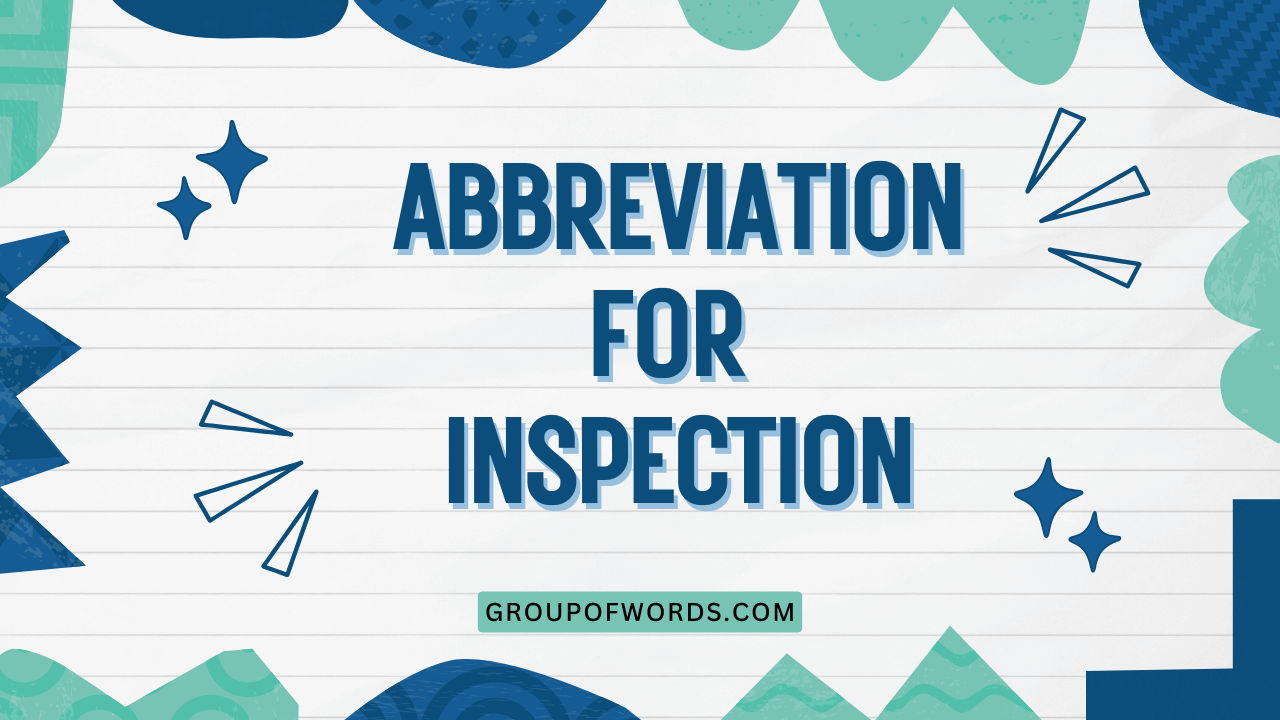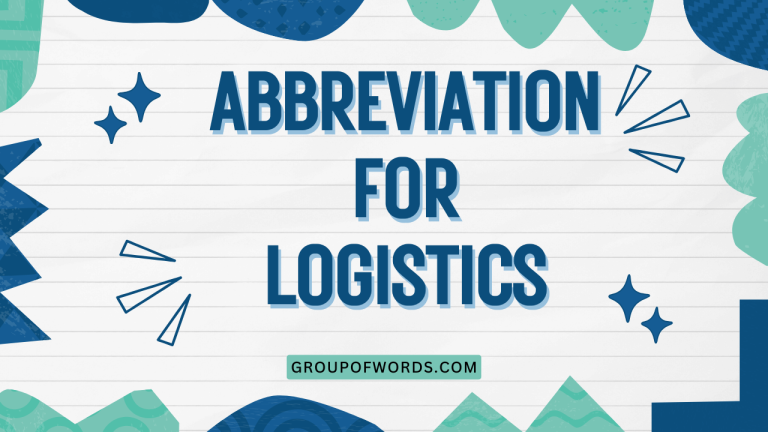Abbreviations for Inspection: A Comprehensive Guide
Understanding abbreviations is crucial in various fields, from engineering and manufacturing to healthcare and quality control. The term “inspection” frequently appears in these domains, and knowing its common abbreviations can significantly improve communication efficiency.
This article offers a detailed exploration of abbreviations for “inspection,” covering their definitions, usage contexts, and practical examples. Whether you’re a student, a professional, or simply an English language enthusiast, this guide will equip you with the knowledge to confidently use and interpret these abbreviations.
This comprehensive guide will benefit professionals who are looking to improve their documentation, students learning about technical fields, and anyone who wants to improve their understanding of common abbreviations. By the end of this article, you’ll have a strong grasp of the various abbreviations for “inspection” and how to use them correctly.
Table of Contents
- Introduction
- Definition of Inspection
- Structural Breakdown of Abbreviations
- Types and Categories of Abbreviations
- Examples of Abbreviations in Use
- Usage Rules for Abbreviations
- Common Mistakes to Avoid
- Practice Exercises
- Advanced Topics
- Frequently Asked Questions
- Conclusion
Definition of Inspection
Inspection is the critical process of examining something carefully to identify any defects, errors, or deviations from specified standards or requirements. It is a systematic evaluation conducted to ensure that a product, service, or process meets predefined criteria. Inspections are performed across numerous industries for quality assurance, safety compliance, and regulatory adherence. The goal is to prevent defective items from reaching consumers or progressing further in a manufacturing process, ultimately safeguarding quality and reducing potential risks.
The function of inspection is multifaceted. It involves identifying problems, verifying conformity, ensuring safety, and improving overall quality.
The context of inspection varies depending on the industry and application. In manufacturing, it might involve checking dimensions of machined parts.
In construction, it could mean verifying structural integrity. In healthcare, it may involve examining medical equipment.
In software development, it entails reviewing code for errors. Each context requires specific inspection methods and criteria.
Structural Breakdown of Abbreviations
Abbreviations are shortened forms of words or phrases. Understanding their structure involves recognizing patterns of shortening, such as truncation, contraction, and acronymy.
Truncation involves cutting off the end of a word (e.g., “approx.” for “approximately”). Contraction removes letters from the middle of a word (e.g., “Dr.” for “Doctor”).
Acronymy uses the initial letters of a phrase to form a new word (e.g., “NASA” for National Aeronautics and Space Administration). For “inspection,” common abbreviations often use truncation or contraction.
Abbreviations for “inspection” typically involve removing vowels or shortening the word to its most recognizable form. For instance, “insp.” is a truncated version, while “INSP” might be an acronym used within a specific organization.
Understanding these structural elements helps in deciphering unfamiliar abbreviations and using them correctly. Knowing whether an abbreviation requires a period (e.g., “Insp.”) or not (e.g., “INSP”) is also essential for maintaining clarity and adhering to stylistic conventions.
Types and Categories of Abbreviations
Abbreviations for “inspection” can be categorized based on their level of formality, the context in which they are used, and whether they are acronyms or simple truncations. Here are some common categories:
General Abbreviations
These are widely accepted abbreviations that can be used in various contexts.
Industry-Specific Abbreviations
Certain industries may have their own standard abbreviations for “inspection” that are unique to their field.
Departmental Abbreviations
Within an organization, different departments might use specific abbreviations for internal communication.
Formal vs. Informal Abbreviations
Some abbreviations are more suitable for formal documents, while others are better suited for informal communication.
Examples of Abbreviations in Use
The following tables provide examples of how abbreviations for “inspection” are used in different contexts. These examples illustrate the variety of abbreviations and their application in real-world scenarios.
Each table includes 20-30 examples to showcase the breadth of usage.
Table 1: General Abbreviations for Inspection
This table showcases general abbreviations for inspection that are widely accepted and understood across different industries and contexts. These are suitable for common documentation and communication.
| Abbreviation | Full Word | Example Sentence |
|---|---|---|
| Insp. | Inspection | The Insp. report is due next week. |
| INSP | Inspection | All products must pass INSP before shipping. |
| Inspections | Inspections | Regular Inspections are crucial for safety. |
| Inspect. | Inspection | The Inspect. process identified several defects. |
| Insp | Inspection | Complete the Insp checklist before proceeding. |
| INSP. | Inspection | The final INSP. was completed successfully. |
| INS | Inspection | The INS team will arrive tomorrow. |
| Inspected | Inspected | The equipment was Inspected yesterday. |
| Inspect | Inspect | Please Inspect the area for any hazards. |
| INSPECTION | Inspection | INSPECTION is a critical part of our process. |
| Insp’n | Inspection | The Insp’n revealed some minor issues. |
| Inspectns | Inspections | Regular Inspectns are scheduled quarterly. |
| INSP-QA | Inspection – Quality Assurance | The INSP-QA team ensures product quality. |
| Insp. Rpt. | Inspection Report | Submit the Insp. Rpt. by Friday. |
| INSP Date | Inspection Date | Record the INSP Date accurately. |
| Insp. Dept. | Inspection Department | Contact the Insp. Dept. for assistance. |
| Insp. Result | Inspection Result | Note the Insp. Result in the log. |
| INS-CHECK | Inspection Check | Perform the INS-CHECK before starting. |
| Inspect. Status | Inspection Status | Update the Inspect. Status daily. |
| Inspection Req. | Inspection Required | Inspection Req. for all new deliveries. |
| Insp. Frequency | Inspection Frequency | Determine the Insp. Frequency based on risk. |
| Insp. Procedure | Inspection Procedure | Follow the standard Insp. Procedure. |
| INS-PASS | Inspection Pass | Item marked as INS-PASS. |
Table 2: Industry-Specific Abbreviations
This table provides examples of abbreviations used in specific industries, such as manufacturing, healthcare, and construction. Understanding these abbreviations requires familiarity with the jargon of each field.
| Abbreviation | Full Word | Industry | Example Sentence |
|---|---|---|---|
| NDT | Non-Destructive Testing | Manufacturing | The NDT revealed no cracks in the weld. |
| QC Insp. | Quality Control Inspection | Manufacturing | The QC Insp. ensures products meet standards. |
| Env. Insp. | Environmental Inspection | Environmental Science | The Env. Insp. found several violations. |
| H&S Insp. | Health and Safety Inspection | Occupational Safety | The H&S Insp. is conducted monthly. |
| Med. Insp. | Medical Inspection | Healthcare | The Med. Insp. ensures equipment is sterile. |
| Struct. Insp. | Structural Inspection | Construction | The Struct. Insp. verified the building’s integrity. |
| Elec. Insp. | Electrical Inspection | Construction | The Elec. Insp. is required before occupancy. |
| Fire Insp. | Fire Inspection | Public Safety | The Fire Insp. checks for safety hazards. |
| San. Insp. | Sanitation Inspection | Public Health | The San. Insp. ensures food safety standards. |
| FAA Insp. | Federal Aviation Administration Inspection | Aviation | The FAA Insp. is mandatory for all aircraft. |
| FDA Insp. | Food and Drug Administration Inspection | Pharmaceuticals | The FDA Insp. ensures drug safety. |
| EPA Insp. | Environmental Protection Agency Inspection | Environmental Compliance | The EPA Insp. reviews compliance with regulations. |
| Bldg. Insp. | Building Inspection | Construction | The Bldg. Insp. is scheduled for next week. |
| Plumb. Insp. | Plumbing Inspection | Construction | The Plumb. Insp. ensures code compliance. |
| Mech. Insp. | Mechanical Inspection | Manufacturing | The Mech. Insp. verifies equipment functionality. |
| Safety Insp. | Safety Inspection | Occupational Safety | Conduct a thorough Safety Insp. daily. |
| HVAC Insp. | Heating, Ventilation, and Air Conditioning Inspection | Construction | The HVAC Insp. ensures system efficiency. |
| Lab Insp. | Laboratory Inspection | Research | The Lab Insp. checks for safety protocols. |
| Gas Insp. | Gas Inspection | Construction | The Gas Insp. is required for new installations. |
| Weld Insp. | Welding Inspection | Manufacturing | The Weld Insp. ensures joint integrity. |
| ISO Insp. | International Organization for Standardization Inspection | Quality Management | The ISO Insp. verifies compliance with standards. |
| GMP Insp. | Good Manufacturing Practice Inspection | Pharmaceuticals | The GMP Insp. ensures product consistency. |
Table 3: Departmental Abbreviations
This table focuses on abbreviations that might be used within specific departments of an organization. These abbreviations are often context-dependent and may not be widely understood outside the department.
| Abbreviation | Full Word | Department | Example Sentence |
|---|---|---|---|
| QI Insp. | Quality Improvement Inspection | Quality Improvement | The QI Insp. aims to enhance processes. |
| Prod. Insp. | Production Inspection | Production | The Prod. Insp. ensures output quality. |
| Maint. Insp. | Maintenance Inspection | Maintenance | The Maint. Insp. identifies potential issues. |
| Eng. Insp. | Engineering Inspection | Engineering | The Eng. Insp. verifies design specifications. |
| IT Insp. | Information Technology Inspection | Information Technology | The IT Insp. checks system security. |
| HR Insp. | Human Resources Inspection | Human Resources | The HR Insp. ensures compliance with policies. |
| Fin. Insp. | Finance Inspection | Finance | The Fin. Insp. audits financial records. |
| Log. Insp. | Logistics Inspection | Logistics | The Log. Insp. ensures efficient operations. |
| Sales Insp. | Sales Inspection | Sales | The Sales Insp. monitors sales performance. |
| Mktg. Insp. | Marketing Inspection | Marketing | The Mktg. Insp. evaluates campaign effectiveness. |
| Cust. Serv. Insp. | Customer Service Inspection | Customer Service | The Cust. Serv. Insp. measures satisfaction. |
| R&D Insp. | Research and Development Inspection | Research and Development | The R&D Insp. assesses project progress. |
| Proc. Insp. | Procurement Inspection | Procurement | The Proc. Insp. ensures compliance with standards. |
| Training Insp. | Training Inspection | Training | The Training Insp. evaluates program effectiveness. |
| Admin. Insp. | Administration Inspection | Administration | The Admin. Insp. checks for policy adherence. |
| Legal Insp. | Legal Inspection | Legal | The Legal Insp. ensures regulatory compliance. |
| Security Insp. | Security Inspection | Security | The Security Insp. assesses physical security. |
| Facility Insp. | Facility Inspection | Facilities Management | The Facility Insp. identifies maintenance needs. |
| Transp. Insp. | Transportation Inspection | Transportation | The Transp. Insp. ensures vehicle safety. |
| Inv. Insp. | Inventory Inspection | Inventory Management | The Inv. Insp. verifies stock accuracy. |
| Plan. Insp. | Planning Inspection | Planning Department | The Plan. Insp. evaluates project feasibility. |
Usage Rules for Abbreviations
Using abbreviations correctly involves understanding specific rules and conventions. Here are some key rules to follow:
- Consistency: Maintain consistent usage of abbreviations throughout a document or communication.
- Clarity: Ensure that the abbreviation is easily understood in its context. If there’s a possibility of confusion, spell out the full word or phrase on the first use, followed by the abbreviation in parentheses.
- Formality: Use formal abbreviations in formal documents and informal abbreviations in informal communications.
- Punctuation: Follow standard punctuation rules for abbreviations, including using periods where appropriate.
- Capitalization: Use capitalization consistently, especially for acronyms.
Abbreviations are most helpful when they are clear and consistent. Before using an abbreviation, consider your audience and the context.
If you’re unsure whether an abbreviation will be understood, it’s always best to spell out the full word or phrase.
Common Mistakes to Avoid
Several common mistakes can occur when using abbreviations. Recognizing these errors can help you avoid them and improve the clarity of your communication.
| Incorrect | Correct | Explanation |
|---|---|---|
| The insp was done. | The Insp. was done. | Using a period after “Insp.” is generally preferred for clarity. |
| We need an INSPECT | We need an INSP | Using the correct abbreviation “INSP” improves efficiency. |
| The Inspections are important but the inspire are not. | The Inspections are important but the inspiration are not. | Confusing the abbreviation of inspections with the word inspiration. |
| The inspection report, insp, is due. | The inspection report (Insp.) is due. | Spelling out the full word on the first use, followed by the abbreviation in parentheses, is clearer. |
| INSP is very import. | INSP is very important. | Mixing abbreviation styles within a sentence. |
| The insp. is very good but the nspect is not. | The insp. is very good but the inspection is not. | Consistency in using the abbreviation or spelling it out completely. |
| The INS team will inspect. | The INS team will conduct an inspection. | Clarity in the sentence by using the full word inspection. |
| The report is required for all process. | The report is required for all processes. | Misunderstanding of the plural form of process. |
| The engineer did the inspect. | The engineer did the inspection. | Using the correct noun from of inspection. |
By being mindful of these common mistakes, you can ensure that your use of abbreviations is accurate and effective. Always double-check your work and consider your audience to avoid confusion.
Practice Exercises
Test your understanding of abbreviations for “inspection” with the following exercises. Each exercise includes multiple-choice questions to assess your knowledge and application of the concepts covered in this article.
Exercise 1: Identifying Correct Abbreviations
Choose the correct abbreviation for “inspection” in each sentence.
| Question | Options | Answer |
|---|---|---|
| The ________ report is due next week. | a) Inspect b) Insp. c) Inspectioning d) Inspt | b) Insp. |
| All products must pass ________ before shipping. | a) INSP b) Inspect c) Inspects d) Inspecting | a) INSP |
| Regular ________ are crucial for safety. | a) Insp. b) Insp c) Inspections d) Inspect | c) Inspections |
| Complete the ________ checklist before proceeding. | a) Inspect b) Inspection c) Insp d) Inspecting | c) Insp |
| The final ________ was completed successfully. | a) Insp b) INSP. c) Inspect d) Inspection | b) INSP. |
| The ________ team will arrive tomorrow. | a) Inspection b) Inspect c) INS d) Insp | c) INS |
| The equipment was ________ yesterday. | a) Insp b) Inspect c) Inspections d) Inspected | d) Inspected |
| Please ________ the area for any hazards. | a) Insp b) Inspection c) Inspect d) Inspections | c) Inspect |
| ________ is a critical part of our process. | a) Insp b) Inspect c) Inspections d) INSPECTION | d) INSPECTION |
| The ________ revealed some minor issues. | a) Inspect b) Insp’n c) Inspection d) Insp | b) Insp’n |
Exercise 2: Filling in the Blanks
Fill in the blanks with the appropriate abbreviation for “inspection.”
| Question | Answer |
|---|---|
| Submit the ________ Report by Friday. | Insp. |
| Record the ________ Date accurately. | INSP |
| Contact the ________ Department for assistance. | Insp. |
| Note the ________ Result in the log. | Insp. |
| Perform the ________ before starting. | INS-CHECK |
| Update the ________ daily. | Inspect. |
| ________ Required for all new deliveries. | Inspection |
| Determine the ________ based on risk. | Insp. |
| Follow the standard ________. | Insp. |
| Item marked as ________. | INS-PASS |
Advanced Topics
For advanced learners, understanding the nuances of abbreviations in technical writing and specific industry contexts is crucial. This involves delving into the history and evolution of these abbreviations, their standardization across different organizations, and their impact on the readability and accessibility of technical documents.
Additionally, exploring the use of context-aware abbreviations, where the meaning of an abbreviation is determined by its surrounding text, can further enhance comprehension.
Consider the role of international standards, such as those set by ISO (International Organization for Standardization), in defining and regulating the use of abbreviations across different countries and industries. Understanding these standards can help ensure consistency and clarity in global communication.
Finally, researching the impact of artificial intelligence and natural language processing on the interpretation and generation of abbreviations can provide valuable insights into the future of technical communication.
Frequently Asked Questions
Here are some frequently asked questions about abbreviations for “inspection,” along with detailed answers to address common concerns and misunderstandings.
- Q: Is it always necessary to use a period after “Insp.”?
A: While not always mandatory, using a period after “Insp.” is generally recommended for clarity, especially in formal writing. It helps distinguish the abbreviation from other words and ensures consistency.
- Q: Can I use “INSP” and “Insp.” interchangeably?
A: While both abbreviations refer to “inspection,” “INSP” is typically used as an acronym, often in all caps, while “Insp.” is a shortened form with a period. The choice depends on the context and the conventions of the organization or industry.
- Q: How do I know which abbreviation is appropriate for a specific industry?
A: The best way to determine the appropriate abbreviation is to consult industry-specific style guides, documentation, or established practices within the field. If unsure, spell out the full word or phrase on the first use, followed by the abbreviation in parentheses.
- Q: Are there any abbreviations for “inspection” that should be avoided?
A: Avoid using overly ambiguous or non-standard abbreviations that might not be easily understood by your audience. Always prioritize clarity and ensure that the abbreviation is widely recognized within the relevant context.
- Q: What if I’m unsure whether my audience will understand an abbreviation?
A: When in doubt, spell out the full word or phrase on the first use, followed by the abbreviation in parentheses. This ensures that everyone understands the meaning of the abbreviation and allows you to use it confidently throughout the rest of the document.
- Q: How do I handle plural forms of abbreviations for “inspection”?
A: For plural forms, you can often simply add an “s” to the abbreviation (e.g., “Insps.”). However, it’s important to maintain consistency and ensure that the plural form is clear and easily understood.
- Q: Is it acceptable to create my own abbreviations for “inspection” within my organization?
A: While creating internal abbreviations can be useful for streamlining communication, it’s crucial to establish a clear and consistent system for defining and using them. Ensure that all members of the organization are aware of these abbreviations and their meanings to avoid confusion.
- Q: Where can I find a comprehensive list of abbreviations for “inspection” used in various industries?
A: While a single comprehensive list may not exist, you can consult industry-specific dictionaries, style guides, and online resources to find relevant abbreviations. Additionally, professional organizations and regulatory agencies often provide lists of standard abbreviations for their respective fields.
Conclusion
Mastering abbreviations for “inspection” is essential for effective communication in various professional and technical contexts. This comprehensive guide has covered the definition, structural breakdown, types, usage rules, and common mistakes associated with these abbreviations.
By understanding these concepts and practicing the exercises provided, you can improve your ability to confidently use and interpret abbreviations for “inspection.”
Remember to prioritize clarity, consistency, and context when using abbreviations. Always consider your audience and ensure that your communication is easily understood.
By following the guidelines outlined in this article, you can enhance your communication skills and contribute to more efficient and effective workflows. Continue to practice and expand your knowledge to stay current with evolving industry standards and best practices.






